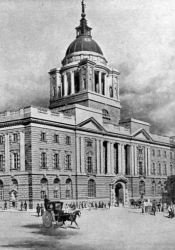The trial of Oscar Wilde
Oscar Wilde was subjected to a total of three trials from March till May of 1895. The first trial saw Wilde taking the Marquess of Queensberry. The second was twenty-five counts of gross indecencies and conspiracy to commit gross indecencies. The final trial was for gross indecency, and Wilde was arrested. The third trial was the nail in the coffin. Starting on May 20th, 1895, Wilde was formally charged with seven counts of gross indecency (alos referred to as sodomy). In an effort to get a conviction, the prosecution presented only the strongest witnesses, and the trial was described as ‘gruesome’ and ‘horrifying’. Wilde was declared guilty on six counts, with the exception being Edward Shelley. He was sentenced to two years of hard labor (the maximum sentence) and served his time at Reading goal. The last two trials took place at the Central Criminal Court of England and Wales, also known as Old Bailey.
Wilde’s trial and the aftermath form an interesting commentary on gender, class and sex. Some of the notable follow-ups are that Lord Douglas was never formally prosecuted and was protect by his father’s status, while Wilde was thrown to the dogs. Another was the speculation that the Liberal government was especially harsh on Wilde because the then Prime Minister Archibald Primrose, Earl of Rosebery was suspected of having an affair with yet another of Queensberry’s sons. It is also interesting to note that prior to these trials, the attitude towards homosexuals was almost pitiful, but after the trial they were viewed as predatory and dangerous. And finally, it is worth noting that despite all of this, lesbianism was not criminalized, and sexual acts between women were for all intents and purposes legal. It was formally added as a part of the Criminal Law Amendment Act in 1921, but was defeated in. the House of Lords.

